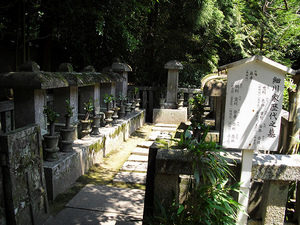Hosokawa Fujitaka

Fujitaka was the son of Mibuchi Harusada, who had been adopted into the Hosokawa family by Hosokawa Mototsune. Fujitaka was a member of the Ashikaga court and during his service to Yoshiteru practiced linked verse with Satomura Joha, the noted renga master. In 1565 Yoshiteru was assassinated and Hosokawa left the capital, joining Ashikaga Yoshiaki in his search for a patron. After Oda Nobunaga established Yoshiaki in Kyoto (1568), Fujitaka continued to act as his advisor. In 1573 Yoshiaki was driven from Kyoto by Nobunaga, who kept Fujitaka in service, as the latter was a noted scholar and poet, as well as an administrator of some skill. He experienced battle for the first time in Nobunaga's campaigns against the Saika Ikki in 1577.[1] In 1580 Fujitaka was given a large fief in Tango (110,700 koku), where he would remain until his death. In 1582 Akechi Mitsuhide destroyed Oda Nobunaga and turned to Fujitaka for support. Although related to Mitsuhide through his son Tadaoki's marriage to Mitsuhide's daughter, Fujitaka refused. He later became a close confident to Toyotomi Hideyoshi and acted as something of a cultural assistant, advising Hideyoshi in the ways of etiquette and verse.
Fujitaka accompanied Hideyoshi in the Kyushu Campaign (1587) and the Odawara Campaign (1590). After Hideyoshi's death in 1598 he retired to his studies, but was approached in 1600 by Ishida Mitsunari's followers who hoped his Toyotomi loyalties might still be in effect. However, it so happened that as a result of one of Ishida's schemes, his son's wife was killed at Ôsaka. This and various other factors led Fujitaka to side with Tokugawa Ieyasu. When the Ishida and Tokugawa went to war, Fujitaka was quickly surrounded in Tanabe Castle, his main residence in Tango (August 1600). As the besiegers had 15,000 and Hosokawa all of 500, Fujitaka's chances seemed slim indeed. Yet it so happened that the commanders of the Western army outside Tanabe respected Fujitaka and were less then fanatical in their efforts to bring down the castle, to the extent that they amused themselves bombarding Tanabe with cannon loaded only with gunpowder. Nonetheless, Fujitaka feared for a collection of priceless works of poetry and history he had with him in the castle. He appealed to the Court to send Maeda Gen'i to come and receive these items lest they be damaged, a request readily granted along with an Imperial request that Fujitaka surrender. This Fujitaka refused to do, and in the end the Emperor sent an Imperial edict ordering Hosokawa to lay down his arms. Hosokawa had little choice but to comply and opened Tanabe's gates on 19 October, two days before the actual Battle of Sekigahara and too late for the besiegers to join Mitsunari's main army. After the Campaign ended, Fujitaka went back into quiet retirement. A man famous for his learning and verse-composition, Fujitaka composed numerous works of poetry, history, and literary review, including a number of well-regarded studies of the Tale of Ise. He was also something of an expert on the history of Kyôto and was consulted by Hideyoshi when the latter sought to make improvements to the city's layout. He was considered the foremost authority on waka, as well as something of an authority on the history of Kyoto.
References
- Initial text from Samurai-Archives.com FWSeal & CEWest, 2005.
- ↑ "Hosokawa-ke to Eisei Bunko," Eisei Bunko Museum pamphlet.